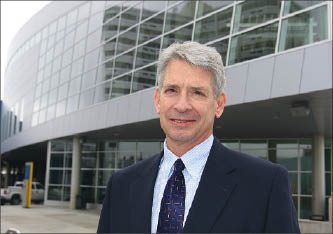
Home » Expanded convention center beating sales projections
Expanded convention center beating sales projections
Arena, performing arts center also show consistent profitability

April 9, 2009
The Spokane Convention Center is exceeding revenue projections that the Spokane Public Facilities District (PFD) developed years ago in anticipation of the center's $89 million in expansion and renovation projects completed in 2006 and 2007, says Kevin Twohig, the district's executive director.
The convention center's 2008 revenue of $3.76 million beat by $478,000 projections the PFD made in 2002, and its 2009 revenue is on track to exceed those original forecasts again by more than $400,000, Twohig says.
The district also operates the INB Performing Arts Center located just west of the Convention Center and the Spokane Veteran's Memorial Arena, north of downtown, both of which have been consistently profitable, he says.
The convention center includes the 100,000-square-foot boat-shaped Group Health Exhibit Hall that opened in 2006 at the northwest corner of Spokane Falls Boulevard and Division Street and the longtime Convention Center building, at 334 W. Spokane Falls Blvd., built for the Expo '74 World's Fair and last renovated in 2007.
In 2008, the convention center's net income totaled $115,000, following losses of $480,000 in 2007 and $82,000 in 2006, Twohig says.
Nationwide, most municipally operated convention centers operate at a loss, and the Spokane PFD can handle such an occurrence, he says.
"The district is fortunate to have two facilities—the arena and the INB Performing Arts Center—that operate profitably and can offset an operating loss at the convention center," he says.
The three facilities had combined net income of $1.5 million in 2008, up from $1.1 million in 2007 and $778,000 in 2006, he says.
Despite the recession, the convention center isn't experiencing cancellations in bookings, although some conventions are having lower attendance due to corporate travel restrictions, Twohig says.
"My experience is that the sports and entertainment business has historically—at least in Spokane—done fairly well during past recessions, and the current one seems to be following the same pattern," he adds. "Attendance at many events is up."
Total attendance, however, isn't always the best indicator of a public facility's profitability, Twohig says.
Convention center activities drew a total attendance of 269,000 people in 2008, down 7.5 percent from 291,000 people in 2007.
"The convention center drew fewer people last year than in 2007, but they spent more," he says.
Bookings that were among the highest attended in 2008 included the Washington state Republican and Democratic conventions, the annual Ag Expo & Pacific Northwest Farm Forum, and the Messenger Assembly of the American Baptist Association.
Convention center activities filled 36,700 Spokane-area hotel rooms during 2008, up from 31,000 in 2007, Twohig says. Future convention-related hotel bookings also look to be ahead of forecasts, he says.
"Hotel room nights generated by major convention bookings for 2009 through 2012 are exceeding (the target) pace by an average of 159 percent for each year," he says.
That bodes well for hotel-development potential here, Twohig says.
"There is a continuous cycle in our community and in most communities with a convention center," he says. "When the convention center expands, hotel demand increases, and when new hotels open, it makes sense to expand the convention center."
The Spokane Veterans Memorial Arena also is meeting budget expectations, Twohig says.
The arena is home to the Spokane Chiefs Western Hockey League team and the Spokane Shock arenafootball2 league franchise.
"Both teams are performing well, and ticket sales are strong," he says. "The Chiefs' attendance is up from last season, and the Shock is going into its season with better-than-expected ticket sales."
Concerts also are selling well, Twohig says, adding that country music artist Taylor Swift's performance scheduled for May 14 sold out in 20 minutes. "That's not a record, but it's great," he says.
The arena's net income was $719,000 in 2008, second only to the $1.2 million in net income posted in 2007.
That year, the arena hosted the U.S. Figure Skating Championships and first- and second-round games of the men's NCAA basketball tournament.
Looking ahead, Twohig notes the arena again will host the U.S. Figure Skating Championships and opening-round games of the NCAA tournament in 2010. "We'll be off to a great start again, then," he says.
The INB Performing Arts Center, a mid-sized venue that hosts the Spokane Symphony, major theatrical tours, and other events too small for the arena, has been profitable every year since the district began operating it in 2003.
That facility generated net income of $646,000 in 2008, up from $371,000 in 2007 and $440,000 in 2006.
Total attendance at the INB Performing Arts Center was 209,923 in 2008, up from 197,477 in 2007.
The Spokane PFD was formed in 1989 by the Washington Legislature to head up efforts to develop a new arena to replace the obsolete 5,400-seat Spokane Coliseum.
The $62 million arena opened six years later at the former coliseum site. The project was funded through a voter-approved 0.1 percent sales tax and a 2 percent room tax assessed on hotels within the PFD. Voters approved an extension of the tax measures in 2002 in part to fund the $89 million convention center expansion and renovation. Washington state also provides a 0.033 percent sales tax rebate that goes toward capital projects in PFDs statewide.
The Spokane PFD's main office is adjacent to the arena, at 720 W. Mallon. The district employs about 40 people, most of whom are spread out between the three public facilities, says Twohig, who's been involved in public-facility management for more than 30 years.
Latest News
Related Articles




